APAC Food Platform-to-Consumer Delivery Market Size
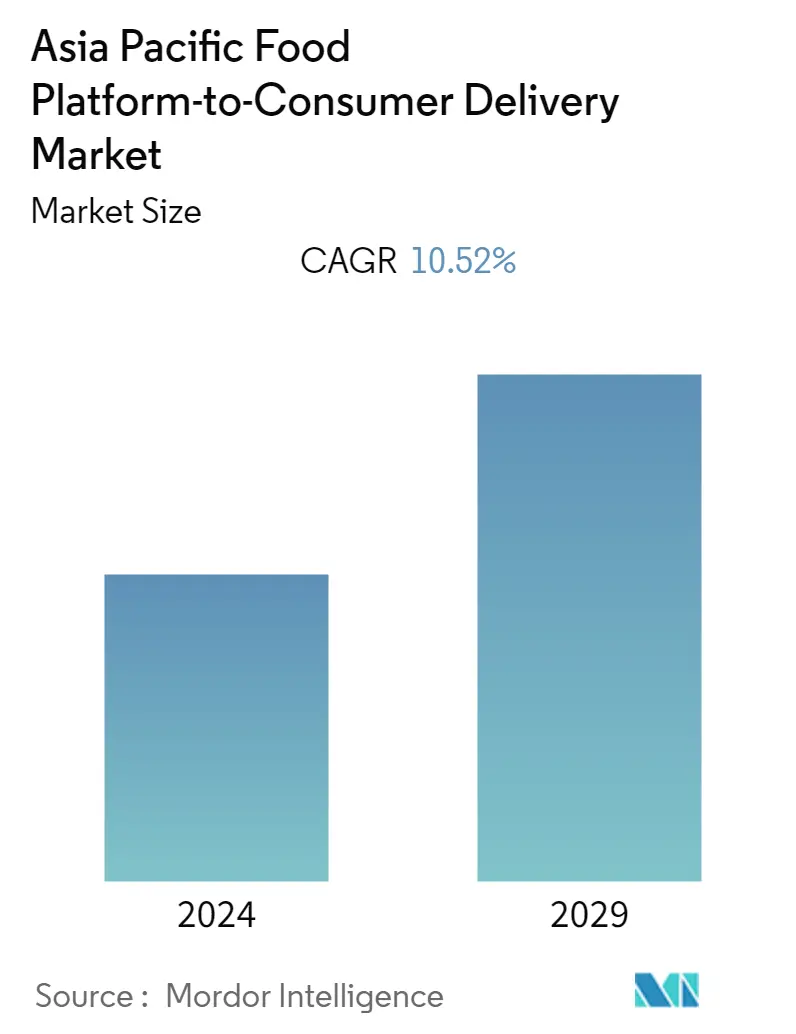
| Study Period | 2019 - 2029 |
| Base Year For Estimation | 2023 |
| Forecast Data Period | 2024 - 2029 |
| Historical Data Period | 2019 - 2022 |
| CAGR | 10.52 % |
| Market Concentration | Low |
Major Players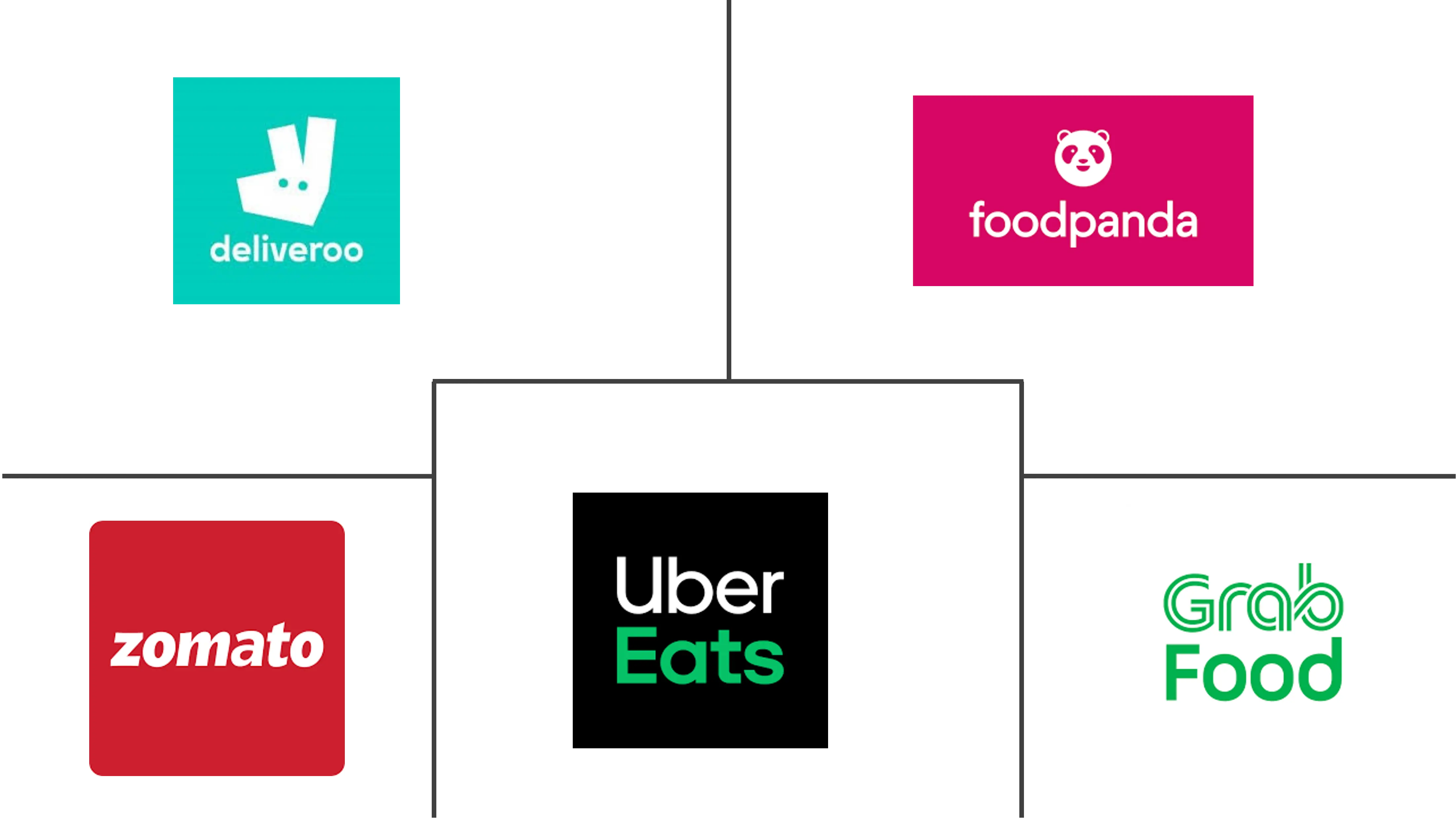
*Disclaimer: Major Players sorted in no particular order |
APAC Food Platform-to-Consumer Delivery Market Analysis
The market for food platform-to-consumer delivery in Asia-Pacific is expanding exponentially. The shift in consumer purchasing habits was brought on by the trend of buying meals through mobile applications. Some of the main factors that have fuelled the market expansion in the region include emerging economies, accessibility, and rising internet and smartphone usage. It is anticipated that the Asia-Pacific Food Platform-to-Consumer Delivery market will expand at a CAGR of 10.52% during the projection period.
- There are more emerging economies in this region than anywhere else, including those of China, India, Indonesia, Thailand, the Philippines, and Vietnam. Due to its favorable demography, robust consumer class expansion, urbanization, quick technological adoption, and digital transformation, this will continue to be one of the fascinating markets over the next 20 years. The improvement in the region's economic position is causing an increase in consumer spending power, which is a key component in the market's expansion.
- Considering the rising adoption and usage of mobile phones, the population of the Asia-Pacific region is becoming increasingly connected to digital information. The number of smartphone connections in APAC, which was 2 billion in 2021, will increase to 2.5 billion in 2025, according to the GSMA. This smartphone increase will help the Food Platform to Consumer Delivery market in the region because the market mostly operates through mobile applications.
- The APAC region is experiencing internet penetrations and 5G rollout in the region by various companies in an aggressive manner. For instance, the second wave of 5G rollouts is currently taking place in the Asia Pacific, with 5G activities gathering speed in several new markets as of 2021. In May, Telkomsel debuted commercial 5G services in Indonesia. In anticipation of their anticipated commercial deployments in 2022, Airtel and Reliance Jio in India have started testing their 5G networks. This is a driving factor for the Food Platform to Consumer Delivery market in the region because, with good network availability, the customers from rural areas can also use mobile devices to order food online.
- It takes considerable time to order with an online food delivery service. Customers looking for fast food should likely visit the restaurant independently rather than utilizing delivery services. Traffic, weather, a restaurant's level of busyness, and the complexity of a customer's order are frequently to blame for longer wait times for online meal delivery. Every service provider in the industry faces challenges in reducing delivery times while maintaining the same price.
- Since the start of the COVID-19 pandemic, multiple lockdowns and restriction measures taken by governments have generated a surge in demand for online food delivery services in the region. The COVID-19 pandemic has expedited the online meal delivery industry's expansion in Asia-Pacific. Additionally, the contactless delivery services provided by most businesses throughout the pandemic have fuelled industry expansion and transformed customer purchasing habits by establishing a new trend of ordering foods online.
APAC Food Platform-to-Consumer Delivery Market Trends
This section covers the major market trends shaping the APAC Food Platform-to-Consumer Delivery Market according to our research experts:
Smart Phones and Internet Penetrations in the region are driving the Market
- The incentive for the mass production of more affordable 5G devices to serve customers in lower income groups could come from the introduction of 5G in significant markets with modest average income levels. For instance, Chinese smartphone maker Realme intends to release 5G-capable devices in India in 2022 for just USD 135. This trend will increase the smartphone adoptions in the region, which will indirectly have a positive impact on the Food Platform to Consumer Delivery Market in the region.
- Mobile operators of all sizes are increasingly embracing open RAN solutions for network deployment and operation, signaling a paradigm shift in the mobile industry's network infrastructure models. Operators in the Asia Pacific have different reasons for implementing open RAN including lowering network deployment and operation costs, particularly in low ARPU market situations like those in rural communities. For example, Axiata Group aims to close the digital divide in rural Malaysia, Indonesia, and Sri Lanka by launching commercial open RAN networks by the end of 2021 with extensive installations. Axiata's partners in its open RAN concept include Mavenir, Parallel Wireless, and systems integrator Infosys. This is driving the Internet Penetration across the region and with this increased accessibility the no of users for Food Platform to Consumer Delivery Applications is increasing in the region.
- In addition, Indosat Ooredoo has teamed up with the Telecom Infra Project (TIP) and Parallel Wireless to carry out a 4G Open RAN field trial. To develop open-RAN compliant technologies for its 5G networks, NTT Docomo collaborated with Samsung to provide users with better 5G services. To launch a 5G network, state-owned National Telecom (NT) has teamed up with Mavenir, 5GCT, and Cisco to open RAN smart city initiative in Thailand's Ban Chang. These all are showing the trend of internet penetration in the region, which is indirectly driving the market.
- The Covid-19 pandemic over the past two years has shown how crucial connectedness is to society's well-being. As a result, ensuring that everyone has access to high-quality, affordable connectivity has risen to the list of priorities for governments in the Asia Pacific and beyond. Mobile connectivity was a lifeline for people and communities during the pandemic, especially for those who had little or no access to traditional types of connectivity. This has impacted the consumers' mindset and enhanced the trust level for online purchases, which is indirectly driving the market in the region.
- According to GSMA, 1.23 billion people in Asia and the Pacific have mobile internet subscriptions by the end of 2021. This amounted to 44% of the total population in the area. Up to 2025, an additional 264 million individuals are anticipated to sign up for mobile internet for the first time, bringing the total number of internet subscribers to 1.49 billion, which is equal to 52% of the population in the region.
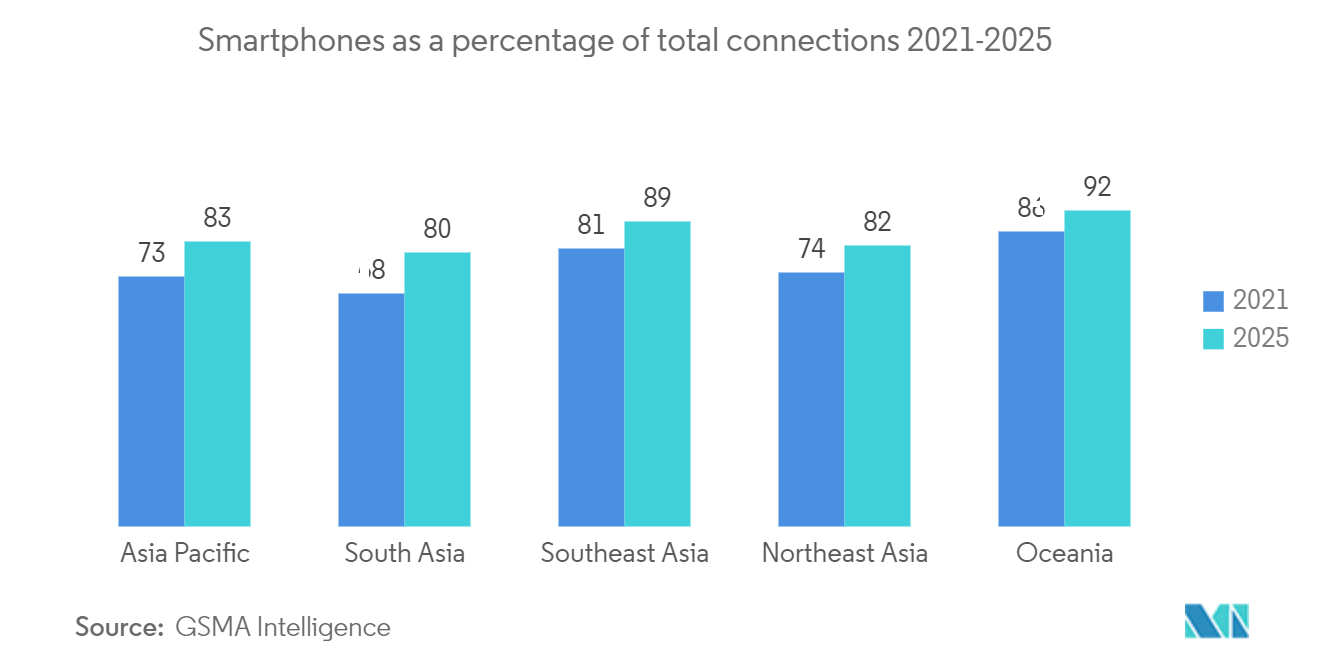
Rising Purchasing Power and Immense younger Population in the Region
- A distinctive and varied collection of economies that serve as a model of the world may be found in Asia and the Pacific region. Along with very small island economies, landlocked economies, and some of the most populated economies in the world, it contains. Additionally, it covers lower-middle-income to high-income economies with a broad variety of statistical capabilities. Emerging economies such as China, India, and Indonesia with developed countries such as Japan, Singapore, and South Korea are contributing to the regions' increasing purchasing power.
- The increasing purchasing power in the region is causing the people's demand for varieties of foods. Through Food Platform to Consumer Delivery, users can have multiple opportunities for food selections. According to Rabobank, Asian consumers' food spending is expected to double by 2030, creating a huge opportunity for investors to provide customers with healthier and more environmentally friendly options.
- In addition, according to the group's "Asia Food Challenge Report 2021," food spending in the region will reach USD 8 trillion by the beginning of the next decade, up from USD 4 trillion in 2019, becoming the largest food and beverage market in the world. It indirectly enhances the Food Platform to Consumer Delivery Market because most of the customers are preferring to buy foods through online delivery platforms.
- The customers in the region are giving priority to the quality of food with the increasing economies. To increase the level of trust among the customers, companies are trying to add their service offerings. For instance, Food panda introduced Green Label, a first-of-its-kind program by a Singaporean food delivery service to advance the sustainability movement through a restaurant certification program.
- According to UNICEF report, a quarter of the world's adolescents live in the East Asia and Pacific region, which is about 329 million. Being more connected, knowledgeable, and eager to offer new perspectives, young people in the region play an important role as change agents. This is driving the APAC Food Platform to Consumer Delivery Market because the young population is generally tech friendly and prefers the online mode of food purchasing.
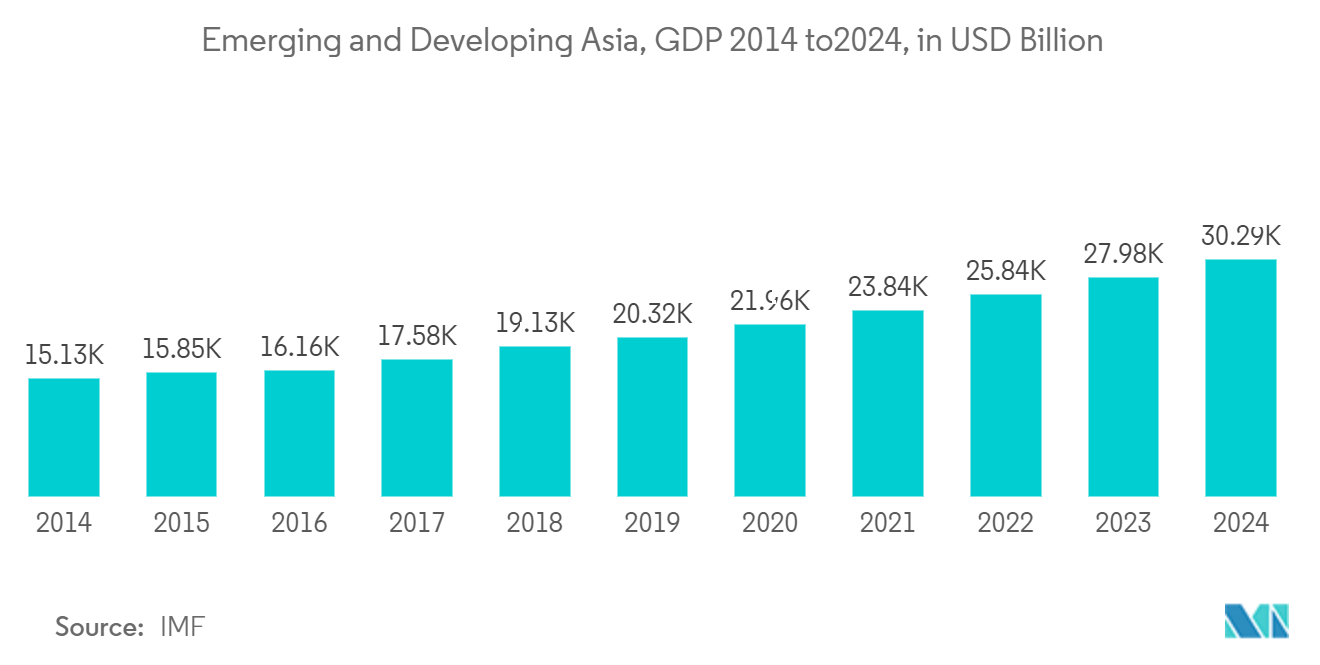
APAC Food Platform-to-Consumer Delivery Industry Overview
Due to the presence of various global and regional players in the market the competition among the companies is very high. Due to the trend of startups, many emerging players are coming up in the market and making it more dynamic. Companies are trying to acquire the market share through various business strategies such as brand promotions, and discount coupon offerings.
- August 2022: Hands-On Trades Private Limited, a provider of storage and auxiliary services for Blinkit, has been acquired by Zomato Hyperpure Private Limited, the food delivery service's business-to-business (B2B) restaurant supply division. Zomato intends to begin integrating Blinkit after the acquisition, beginning with customers and delivery fleets. It might also think about transferring Blinkit to the Zomato app.
- August 2022: GoFood, an online food delivery service, has been launched on the Tokopedia app by GoTo Group, the combined company of Indonesian internet companies Gojek and Tokopedia, to capitalize on integration synergies. The service is currently accessible in the Greater Jakarta region, where customers can also utilize the GoPay e-wallet to make payments.
APAC Food Platform-to-Consumer Delivery Market Leaders
-
Deliveroo
-
Foodpanda
-
Grab Food
-
Uber Eats
-
Zomato
*Disclaimer: Major Players sorted in no particular order
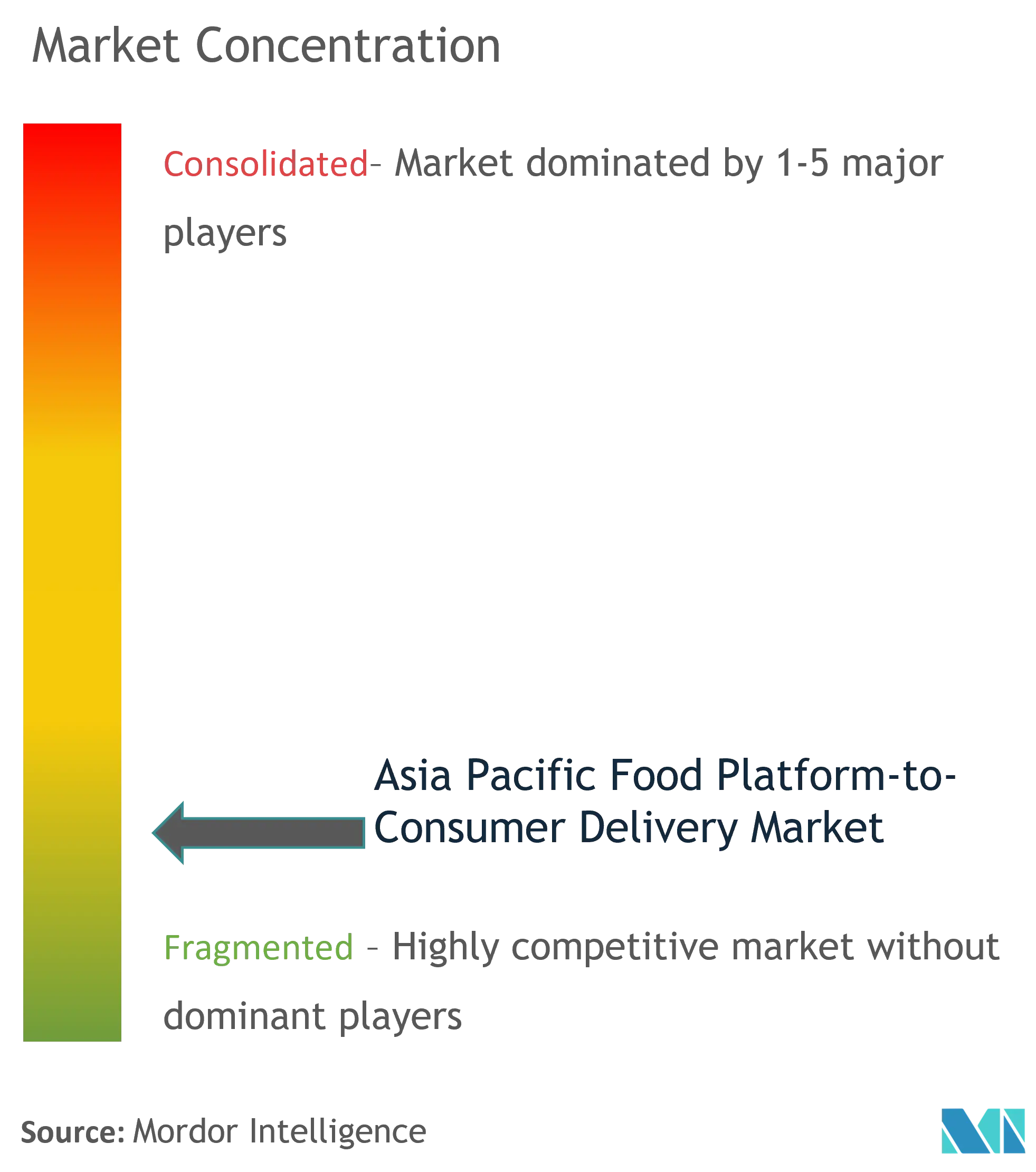
APAC Food Platform-to-Consumer Delivery Market News
- August 2022: The introduction of GrabFood in Phnom Penh was announced by Grab following a successful four-month "beta" test in the capital. GrabFood is the top meal delivery service in Southeast Asia, connecting customers to a wide range of food and drink options and providing on-demand delivery to customers' doors. With the new service, customers may save up to 50% when they order from GrabFood no matter how far away the restaurant or cafe is from the user's location.
- August 2022: Uber Eats has planned to lessen the stress on delivery drivers using their network to match the rising cost of living. With delivery bike media owner MotionAds, Uber Eats has excited to launch a partnership that would provide delivery personnel with a chance to supplement their income through top box advertising.
- August 2022: To reduce food waste and operating costs in the face of the nation's escalating inflation, Deliveroo Singapore has partnered with the social company TreeDots. The collaboration with TreeDots will give restaurants a way to reduce food procurement expenses for a variety of high-quality goods and maintain profitable profit margins.
APAC Food Platform-to-Consumer Delivery Market Report - Table of Contents
1. INTRODUCTION
- 1.1 Study Assumptions and Market Definitions
- 1.2 Scope of the Study
2. RESEARCH METHODOLOGY
3. EXECUTIVE SUMMARY
4. MARKET INSIGHTS
- 4.1 Market Overview
-
4.2 Industry Attractiveness - Porter's Five Force Analysis
- 4.2.1 Threat of New Entrants
- 4.2.2 Bargaining Power of Buyers/Consumers
- 4.2.3 Bargaining Power of Suppliers
- 4.2.4 Threat of Substitute Products
- 4.2.5 Intensity of Competitive Rivalry
- 4.3 Assessment of COVID-19 Impact on the market
5. MARKET DYNAMICS
-
5.1 Market Drivers
- 5.1.1 Increasing Mobile Penetration
- 5.1.2 Surge in Internet Penetration
- 5.1.3 Ease of Access and Discount on orders
-
5.2 Market Challenges
- 5.2.1 Data Security and Risk Associated with Online Transaction
- 5.3 Market Opportunities
6. MARKET SEGMENTATION
-
6.1 Geography
- 6.1.1 China
- 6.1.2 India
- 6.1.3 South Korea
- 6.1.4 Rest of Asia-Pacific
7. COMPETITIVE LANDSCAPE
-
7.1 Company Profiles
- 7.1.1 Deliveroo
- 7.1.2 Dahmakan
- 7.1.3 LINE Man
- 7.1.4 Kims Kitchen
- 7.1.5 Zomato
- 7.1.6 FoodPanda
- 7.1.7 GoJek
- 7.1.8 GrabFood
- 7.1.9 Delivery Guy
- 7.1.10 SmartBite
- 7.1.11 UberEats.
- 7.1.12 Swiggy
- *List Not Exhaustive
8. INVESTMENT ANALYSIS
9. MARKET OPPORTUNITIES AND FUTURE TRENDS
** Subject To AvailablityAPAC Food Platform-to-Consumer Delivery Industry Segmentation
Food Platform-to-Consumer Delivery market cover revenues of an online business that acts as an intermediary between consumers and multiple food facilities to submit food orders from a consumer to a participating food facility and to arrange for the delivery of the order from the food facility to the consumer. A food platform to consumer delivery model is a business model where the customers can get their favorite food by making an order via their smartphones or computers.
Asia Pacific Food Platform-to-Consumer Delivery market has been segmented based on the geography - China, India, South Korea, and the Rest of Asia Pacific.
| Geography | China |
| India | |
| South Korea | |
| Rest of Asia-Pacific |
APAC Food Platform-to-Consumer Delivery Market Research FAQs
What is the current Asia Pacific Food Platform-to-Consumer Delivery Market size?
The Asia Pacific Food Platform-to-Consumer Delivery Market is projected to register a CAGR of 10.52% during the forecast period (2024-2029)
Who are the key players in Asia Pacific Food Platform-to-Consumer Delivery Market?
Deliveroo , Foodpanda, Grab Food, Uber Eats and Zomato are the major companies operating in the Asia Pacific Food Platform-to-Consumer Delivery Market.
What years does this Asia Pacific Food Platform-to-Consumer Delivery Market cover?
The report covers the Asia Pacific Food Platform-to-Consumer Delivery Market historical market size for years: 2019, 2020, 2021, 2022 and 2023. The report also forecasts the Asia Pacific Food Platform-to-Consumer Delivery Market size for years: 2024, 2025, 2026, 2027, 2028 and 2029.
Asia Pacific Food Platform-to-Consumer Delivery Industry Report
Statistics for the 2024 Asia Pacific Food Platform-to-Consumer Delivery market share, size and revenue growth rate, created by Mordor Intelligence™ Industry Reports. Asia Pacific Food Platform-to-Consumer Delivery analysis includes a market forecast outlook 2029 and historical overview. Get a sample of this industry analysis as a free report PDF download.



